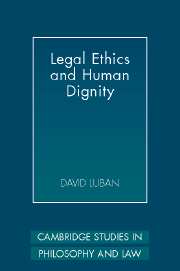Book contents
- Frontmatter
- Contents
- Acknowledgments
- Introduction
- I The ethics in legal ethics
- II The jurisprudence of legal ethics
- 3 Natural law as professional ethics: a reading of Fuller
- 4 A different nightmare and a different dream
- 5 The torture lawyers of Washington
- III Moral complications and moral psychology
- IV Moral messiness in professional life
- Index
4 - A different nightmare and a different dream
Published online by Cambridge University Press: 22 September 2009
- Frontmatter
- Contents
- Acknowledgments
- Introduction
- I The ethics in legal ethics
- II The jurisprudence of legal ethics
- 3 Natural law as professional ethics: a reading of Fuller
- 4 A different nightmare and a different dream
- 5 The torture lawyers of Washington
- III Moral complications and moral psychology
- IV Moral messiness in professional life
- Index
Summary
Nearly thirty years ago, H. L. A. Hart observed that American jurisprudence “is marked by a concentration, almost to the point of obsession, on the judicial process, that is, with what courts do and should do, how judges reason and should reason in deciding particular cases.” Then as now, the figure of the judge dominated American jurisprudence – and wrongly so, in my view. In this chapter I want to explore the hypothesis that a better standpoint for jurisprudence is that of the lawyer, not of the judge. If so, I suggest, legal ethics – regarded by some as a minor and trivial subject – undergoes a remarkable, Cinderella-like transformation to a central spot in how we understand law.
The argument that follows is lengthy but essentially simple. It may be useful to set out its main conclusions here at the beginning. First, taking off from Hart's important insight that a system of rules counts as a legal system only if its institutional actors maintain an internal point of view on the rules, I argue that the most significant actors are not judges, nor, as Hart believes, officials more generally, but lawyers. The lawyer–client consultation is the primary point of intersection between “The Law” and the people it governs, the point at which the law in books becomes the law in action. Second, in singling out lawyer–client consultations as the paradigmatic legal events, I emphasize the role of the lawyer as advisor rather than the lawyer as advocate.
- Type
- Chapter
- Information
- Legal Ethics and Human Dignity , pp. 131 - 161Publisher: Cambridge University PressPrint publication year: 2007

